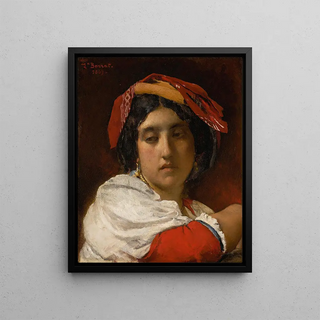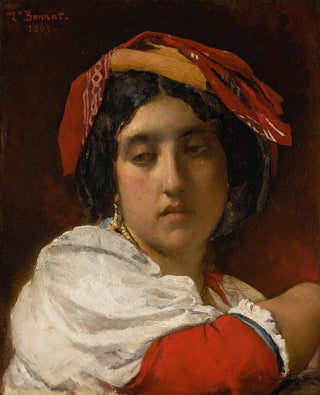Art print | The Italian Woman - Léon Bonnat


View from behind

Frame (optional)
Reproduction of The Italian Girl - Léon Bonnat – Captivating Introduction
Léon Bonnat's "The Italian Girl" is a true ode to feminine beauty and grace, capturing the very essence of 19th-century academic art. Through this canvas, Bonnat transports us into a universe where light and shadow engage in a delicate dance, highlighting the features of a face imbued with serenity and mystery. The composition, both simple and striking, invites the viewer to delve into the emotions and thoughts of the depicted figure, while celebrating Italian cultural richness. This iconic piece showcases Bonnat's undeniable talent, who masterfully combined impeccable technique with artistic sensitivity to create a timeless work.
Style and uniqueness of the work
Léon Bonnat's style is characterized by an exceptional mastery of pictorial techniques, but also by a unique approach to human representation. In "The Italian Girl," the painter uses a subtle color palette, where warm and cool nuances complement each other harmoniously. The texture of the paint, both smooth and vibrant, imparts unparalleled depth to the facial features, emphasizing the classical beauty of his model. The pose, both natural and thoughtful, reveals a rare intimacy, as if the viewer is invited to share a privileged moment with this mysterious woman. The decorative elements, though discreet, contribute to the overall atmosphere of the work, reinforcing this impression of elegance and refinement.
The artist and his influence
Léon Bonnat, born in 1833 in Bayonne, was a French painter whose artistic journey was marked by an relentless pursuit of perfection. Trained at the École des Beaux-Arts in Paris, he quickly established himself as one of the most prominent artists of his time. Influenced by old masters such as Raphael and Titian, Bonnat developed a style that combines tradition and modernity, while standing out for a particular sensitivity to the psychology of his subjects. His work not only defined his era but continues to inspire many contemporary artists. Through "The Italian Girl," he manages to transcend

Matte finish

View from behind

Frame (optional)
Reproduction of The Italian Girl - Léon Bonnat – Captivating Introduction
Léon Bonnat's "The Italian Girl" is a true ode to feminine beauty and grace, capturing the very essence of 19th-century academic art. Through this canvas, Bonnat transports us into a universe where light and shadow engage in a delicate dance, highlighting the features of a face imbued with serenity and mystery. The composition, both simple and striking, invites the viewer to delve into the emotions and thoughts of the depicted figure, while celebrating Italian cultural richness. This iconic piece showcases Bonnat's undeniable talent, who masterfully combined impeccable technique with artistic sensitivity to create a timeless work.
Style and uniqueness of the work
Léon Bonnat's style is characterized by an exceptional mastery of pictorial techniques, but also by a unique approach to human representation. In "The Italian Girl," the painter uses a subtle color palette, where warm and cool nuances complement each other harmoniously. The texture of the paint, both smooth and vibrant, imparts unparalleled depth to the facial features, emphasizing the classical beauty of his model. The pose, both natural and thoughtful, reveals a rare intimacy, as if the viewer is invited to share a privileged moment with this mysterious woman. The decorative elements, though discreet, contribute to the overall atmosphere of the work, reinforcing this impression of elegance and refinement.
The artist and his influence
Léon Bonnat, born in 1833 in Bayonne, was a French painter whose artistic journey was marked by an relentless pursuit of perfection. Trained at the École des Beaux-Arts in Paris, he quickly established himself as one of the most prominent artists of his time. Influenced by old masters such as Raphael and Titian, Bonnat developed a style that combines tradition and modernity, while standing out for a particular sensitivity to the psychology of his subjects. His work not only defined his era but continues to inspire many contemporary artists. Through "The Italian Girl," he manages to transcend






